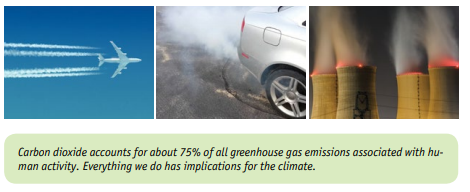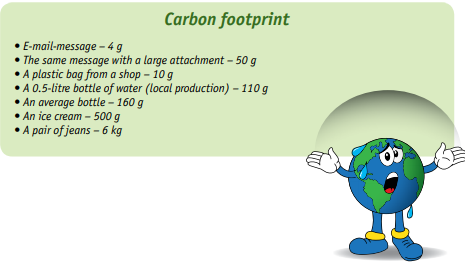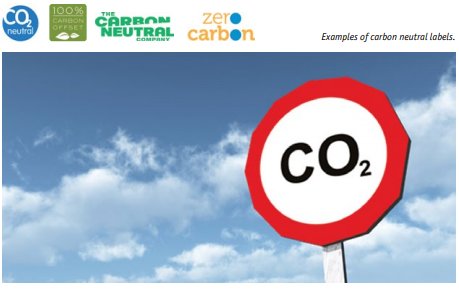Any human activity, which uses energy, has impact on the climate.
We drive cars, travel to other cities and countries by aircraft, use the TV and computer, cook food and put food in the refrigerator. We cut down forests to make paper and furniture. We switch on the heating in winter and air conditioning in summer, and we use electric light in
our homes all the year round. By doing all these things, we each leave our own personal carbon footprint in the world.
The carbon footprint of a city or country is the total amount of all greenhouse gases that all individuals and organizations within this city or country produce by the things they do, events they take part in and products they consume directly or indirectly.

Environmentally responsible behaviour means thinking about how you can reduce greenhouse gas emissions and your own carbon footprint.
It is common practice to translate all greenhouse gas emissions into CO2 equivalent for ease of understanding and calculation. This amount is shown as units of CO2-equivalent.

Direct emissions are amounts of carbon dioxide created by the use of fossil fuels. For example, the amount of greenhouse gases emitted during operation of a factory or a vehicle engine.
Indirect emissions are the amount of CO2 released into the atmosphere when energy is produced and transported in order to make the products that you buy and the services that you need. This is the part of the carbon footprint, which we can influence: we can think twice and not buy disposable cups, think twice and walk instead of going by car, think twice and not use the washing machine at half load.
Calculating the size of our carbon footprint (especially indirect emissions) is difficult, because we have to take account of many different factors and find a lot of information. In addition, the carbon footprint of a product will always be the same for the producer, but it will be different for different consumers because transport and other costs of delivering the product to the consumer have to be taken into account.
For example, the carbon footprint of an apple from the garden, eaten under the tree where it grew, is 0 g of CO2. If you buy apples grown in your region in season (i.e. in summer and early autumn), the carbon footprint of an apple is 10 g of CO2. The carbon footprint of an imported apple (for example, one brought from Italy) will be 150 g of CO2.
Environmentally responsible firms offset their carbon footprint by planting trees and obtaining certificates from reputable carbon-offsetting companies.

Questions
1. What is a carbon footprint?
2. What units are used to measure a carbon footprint?
3. Which of these has a bigger carbon footprint: strawberries grown in the garden at the local farm, or strawberries brought from abroad and beautifully packaged? Why?

Tasks
Task 1. Test, ‘My carbon footprint’
A. When you buy fruits and vegetables in a shop, what do you usually choose:
– local, unpackaged produce (1 point);
– unpackaged produce from the southern regions of your country
(2 points);– unpackaged produce from France, the Netherlands, Argentina and other countries (3 points);
– imported produce, individually pre-packed (4 points)?
B. The bag you use for shopping is:
– linen or cotton (1 point);
– paper (2 points);
– a plastic bag that I take from home (3 points);
– a plastic bag that I take or buy when I pay for goods in the shop
(4 points).
C. When you buy drinks, what sort of container are they usually in?
– paper (1 point);
– glass (2 points);
– aluminum (3 points);
– plastic (4 points)?
D. What book do you prefer to read:
– a new one, bought in a shop (4 points);
– an electronic one (3 points);
– one that has already been read (2 points);
– one from the library (1 point)?
E. When you give someone a present, do you prefer:
– bright and attractive wrapping paper, whatever it is made of (4 points);
– paper with an environmental label to show that it is recyclable (2 points);
– a used box or bag that I specially decorate (2 points);
– to give the present without packaging (1 point)?
Answers to the test ‘My carbon footprint’:
Great! You have the carbon footprint of a mouse! You can be proud of yourself – all you need From 5 to 7 points:
to do now is persuade others to be like you.
You have the carbon footprint of a cat’s paw! But don’t sit purring – you could do even better. From 8 to 10 points:
The carbon footprint of a horse’s hoof! Put on your harness and get down some energy From 11 to 13 points:
saving.
An elephant’s carbon footprint! Better put all that weight into saving energy. From 14 to 16 points:
